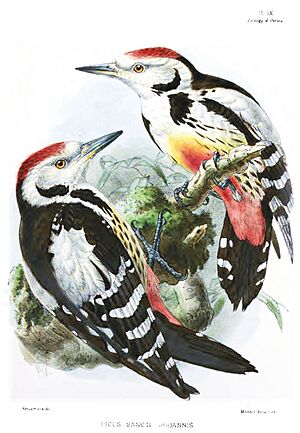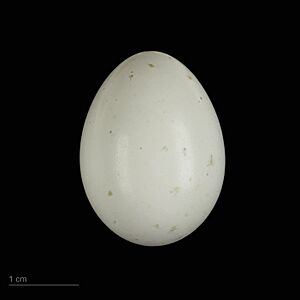Middle spotted woodpecker facts for kids
Quick facts for kids Middle spotted woodpecker |
|
|---|---|
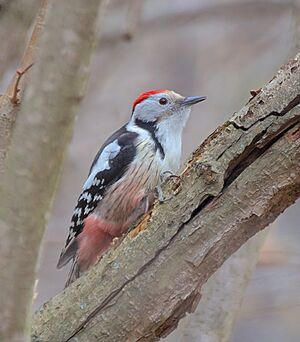 |
|
| Conservation status | |
| Scientific classification | |
| Genus: |
Dendrocoptes
|
| Species: |
medius
|
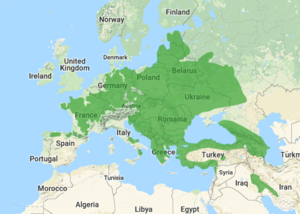 |
|
| Range of D. medius | |
| Synonyms | |
|
|
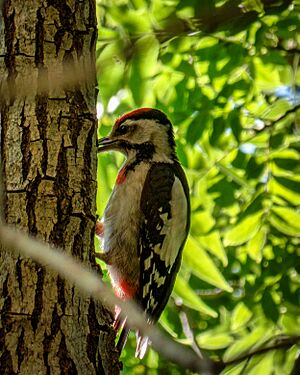
The middle spotted woodpecker (Dendrocoptes medius) is a type of woodpecker found in Europe. It belongs to a group of birds called Dendrocoptes. This bird is known for its unique look and how it finds food in trees.
Contents
How Scientists Classify This Bird
The middle spotted woodpecker was first officially described by a Swedish scientist named Carl Linnaeus. He did this in 1758 in his famous book, Systema Naturae. He gave it the scientific name Picus medius. The word "medius" means "intermediate" in Latin.
For many years, this woodpecker was placed in a different group, or genus, called Dendrocopos. However, in 2015, scientists studied the bird's DNA. They found that the old grouping wasn't quite right. Because of this, the middle spotted woodpecker was moved to a different, older genus called Dendrocoptes.
There are four main types, or subspecies, of the middle spotted woodpecker:
- D. m. medius: Found from Europe to western Russia.
- D. m. caucasicus: Lives in northern Turkey and the Caucasus region.
- D. m. anatoliae: Found in western and southern Turkey.
- D. m. sanctijohannis: Lives in the Zagros Mountains in southwest Iran.
What Does It Look Like?
The middle spotted woodpecker is about 20–22 cm (8–9 inches) long. It looks a lot like the great spotted woodpecker. Its upper body is mostly black with white patches on its wings. Its belly is white, and its wings have white stripes.
Here are some ways to tell it apart:
- It has a bright red cap on its head.
- It does not have a black stripe under its eye, like a mustache.
- Its lower belly is pink.
- It has dark streaks on its sides.
Even though it's only a little smaller than the great spotted woodpecker, it often looks smaller. This is because it has a shorter, thinner beak and a rounder, paler head. It can also be confused with the Syrian woodpecker. You can tell them apart because the middle spotted woodpecker has a smaller beak. Also, its red cap does not have thin black lines on the sides.
Where Does It Live?
The middle spotted woodpecker lives only in Europe and parts of Asia, in a region called the Palearctic. You can find it from northern Spain and France all the way east to Poland and Ukraine. It also lives south to central Italy, the Balkan Peninsula, Lithuania, Latvia, Turkey, the Caucasus, and Iran.
This bird is common in Estonia. However, it is almost never seen in Finland. It used to live and breed in Sweden, but it disappeared from there in the 1980s. Recently, though, middle spotted woodpeckers have been seen in Sweden again. This suggests they might be moving back into the country.
Because these birds don't travel far, they have never been seen in the British Isles. They prefer to live in deciduous forests. These are forests where trees lose their leaves in the fall. They especially like areas with old oak, hornbeam, and elm trees. They also like places with a mix of open areas, pastures, and thick woodlands.
Daily Life and Habits
The middle spotted woodpecker likes to feed high up in the trees. It moves around a lot, which can make it hard to spot.
When it's time to have babies, the woodpecker digs a nest hole. It makes this hole about 5 cm (2 inches) wide in a rotting tree trunk or a thick branch. The female bird lays four to seven eggs. Both parents take turns sitting on the eggs for 11–14 days until they hatch.
This woodpecker mainly eats insects and their young (larvae). It finds them by picking them off branches and twigs. It doesn't usually hack through the bark like some other woodpeckers. It will also drink tree sap.
You rarely hear this woodpecker drumming on trees. When it does, it's not usually to mark its territory. Instead, it uses its song to tell other birds where its home is. Its song is a slow, nasal sound that sounds like gvayk gvayk gvayk gvayk gvayk. It also makes quick calls that sound like kik kekekekek.



